Ryan J. Franklin DDS, MS
ryan j franklin
Call Now
(559) 683-4700
Ryan J. Franklin DDS, MS
ryan j franklin
(559) 683-4700
If your dentist has referred you to our office for root canal therapy, you're not alone. Millions of teeth are treated by endodontists each year and are saved by the endodontic procedures that the specialty performs. When performed by an endodontic specialist, root canal therapy is highly successful and sees nearly a 96% success rate.
As an endodontic patient of our office, you can expect a comprehensive examination to properly diagnose and determine if the tooth in question is a good candidate for endodontic therapy. The current condition of your tooth will be explained in detail, as well asl potential and viable treatment options. The following section explains the multiple methods of root canal therapy and how such treatment can relieve your tooth pain, restore tooth function, and save your smile.
What is endodontics?
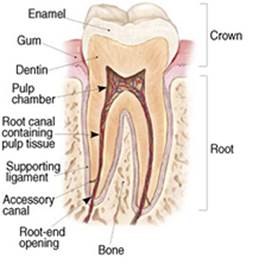
To better understand endodontic treatment, it may be helpful to understand the nomenclature of our specialty, as well as some basic tooth anatomy:
-“Endo” is the Greek word for “inside,” while “odont” is the Greek word for “tooth.” Endodontic therapies are therefore aimed at treating the inside of the tooth, also known as the “pulp” or root canal space.
-The anatomy of a tooth is comprised of both hard calcified tissue as well as non-mineralized, connective tissue. The pupal space resides beneath both the hard outer layer, known as the enamel, and the intermediate layer of softer tooth structure known as dentin. The pulp contains connective tissues, blood vessels, and nerves and is what allows the hard surrounding tissues of the tooth (enamel and dentin) to form during tooth development.
Once a tooth is fully mature it can survive without the pulp. In fact, the pulp serves little purpose once a tooth has reached full development. Under the right circumstances this pulpal space may indeed serve as an ideal environment for bacteria to thrive in, should decay or a crack ever reach this depth. Once bacteria have reached the pulp, our immune system as well as antibiotics are inadequate in eliminating the bacteria from the tooth. As a consequence, root canal therapy is most often required to save the tooth and eliminate the infections potential to eventually affect the jaw bone. Root canal therapy, or endodontic treatment, therefore works to resolve or prevent infection within the pulpal, or root canal, space. Depending on a variety of clinical factors, there are three main treatment methods by which disinfection of the root canal system may be achieved. Namely, these treatment modalities include root canal therapy, endodontic retreatment, and endodontic surgery; also known as apicoectomy. We are experts in performing all three of these procedures. These are further explained in the sections that follow.
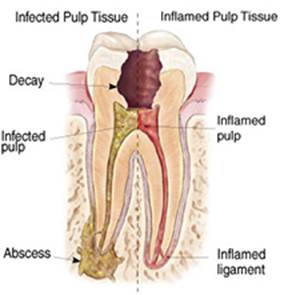
What is root canal therapy?
Root canal therapy is a non-surgical treatment aimed at removing the pulp, disinfecting the pulpal space with the variety of irritants and medicaments and then sealing the canals with permanent root canal fillings. Root canal therapy is the term and treatment method used for teeth that have never had prior root canal therapy.
Why would I need root canal therapy?
Inflammation and infection of the pulp can be caused by deep decay, traumatic injury, cracks or repeated dental procedures.
Symptoms of pulp inflammation and infection include temperature sensitivity, spontaneous pain, discomfort in chewing, swelling in the gums and visible injury to the tooth. If you experience any of these symptoms, your dentist will most likely recommend our endodontic specialist to evaluate your symptoms and teeth for potential endodontic problems.
Ultimately, an infected tooth which is left untreated, may result in extreme pain, loss of the tooth, and erosion of the surrounding jaw bone.
How is root canal therapy performed?
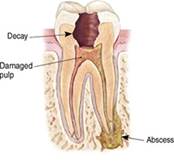
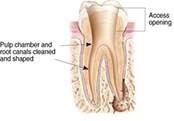
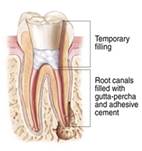
The root canal space is accessed through the biting surface of the tooth or crown. At this time, all decay (if present) is removed. If a crack is deemed responsible for bacteria entering into the pulp, the crack is carefully assessed to determine its depth. The canals are instrumented, sterilized and then sealed with a specialized material called gutta percha. The access cavity made through the biting surface is then either restored permanently (with a long-lasting restoration) or restored with a temporary filling. The restoration method depends on the request of your referring dentist.
In most cases, further treatment with your general dentist will be required following root canal therapy, as most teeth require a crown. The crown protects the tooth from the continous stresses caused by mastication. Note that any tooth with a history of a crack extending into the pulp should be crowned following root canal therapy. This should be done as soon as possible. Teeth that already have a sound crown prior to the root canal therapy, do not require a new crown following the root canal treatment.
Root canal therapy is performed under local anesthetic. We are highly proficient in administering anesthetic and easily accomodate patients who feel anxious and/or “hard-to-get-numb." Although certain tooth conditions can limit the effect of anesthetic, a patient should expect to be extremely comfortable. This is our ultimate goal.
Occasionally, nitrous oxide analgesia and/or oral conscious sedation is used in conjunction with our local anesthesia.
Root canal therapy is most commonly completed in one visit which typically lasts between 60 and 90 minutes. In cases of dental trauma, large abscesses, or signs of significant intra or extra-oral swelling, root canal therapy may likely require two visits.
Our goal is to save your tooth and restore it back to optimal function and aesthetics. Please be mindful however that on occasion, decay or a crack can compromise a tooth too deeply. In such cases it may be determined that your tooth is not amenable to root canal therapy. Most often these complications can be detected at the time of consultation. Occassionally, such obstacles may not be clearly evident until treatment begins. In rare cases, these obstacles are discovered post treatment. In these instances, future removal of the tooth may be required.
What happens after treatment?
Upon completion of root canal treatment, both a case report and copy of the final x-ray will be sent to your referring dentist. You must contact their office to make arrangements for the placement of the permanent crown or filling within the coming weeks (if applicable). Your restorative dentist will decide on what type of restoration is necessary to further protect your tooth and whether or not a crown is necessary.
Post-operative pain following root canal therapy may range from zero sensitivity to mild sensitivity for a few of days. Most sensitivity can be easily controlled with the use of anti-inflammatory medication. Occasionally antibiotics or stronger pain medication is prescribed. Most patients should refrain from chewing hard foods for the intital days following treatment. If a crack was involved in the cause of the infected tooth, a diet consisting of soft foods is recommended until the tooth can be further protected by a crown.
It is rare for endodontic patients to experience complications following routine endodontic treatment. If a problem should occur however, we are available both regular business hours as well as after hours to assist you.
How much will it cost?
The cost associated with this root canal therapy can vary depending on a variety of factors including the severity of damage to the affected tooth and which tooth is treated. In general, endodontic treatment is significantly less expensive than tooth removal and replacement with an artificial tooth. Our team at the front desk will provide you with an estimated fee schedule prior to the initiation of treatment.
Most endodontically treated teeth last as long as other natural teeth. In some cases however, a tooth that has undergone endodontic treatment fails to heal completely, or has persistent discomfort. Other times, the tooth heals completely, but years later becomes reinfected if exposed to new bacteria caused by a defective crown, a new crack or new decay. When this occurs, redoing the root canal therapy, also known as endodontic retreatment, may be required to ensure the longevity of the tooth.
What causes an endodontically treated tooth to require additional treatment?
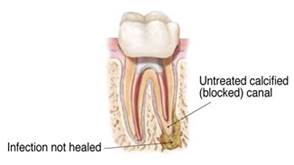
Improper healing, or reinfection of a tooth, may be caused by a number of factors, but namely fall within one of the following categories:
Anatomical Complexities:
Occasionally a tooth's anatomical complexities and irregularities can pose challenges in allowing full resolution of the initial root canal infection. Excessively calcified canals or extremely curved canals may limit the practitioners ability to detect, shape and disinfect a canal to its full length. Note that this is very infrequently encountered with teeth that have been previously treated by an endodontic specialist.
Resistant pathology:
Teeth with large infections extending beyond the root tip and into the surrounding jaw bone may see reduced success following the initial root canal therapy. These larger infections can be more susceptible to developing stubborn cysts that reduce the ability of the tooth and the bone to heal. Other times, these large initial infections allow bacteria to form that are resistant to the medications conventionally used during first time root canal therapy.
Exposure to New Bacteria:
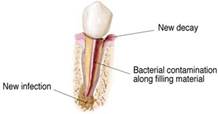
Most often, however, teeth require endodontic retreatment because a tooth becomes re-infected long after healing from the initial root canal therapy. This is possible due to exposure of the root canal fillings to new bacterial contamination. This may result from new deep decay, a defective and “leaky” crown, deep splintering of a crack, or new trauma to a tooth. All of these factors may precipitate recontamination of the root canal system.
If root canal therapy didn’t fix my tooth, how can endodontic retreatment?
Note that the vast majority of teeth that fail to heal after root canal therapy, are not initially treated by endodontic specialists. Endodontists are experts at root canal therapy and retreating cases that have shown signs of continued infection. This success is accomplished through a refined knowledge and understanding of root canal anatomy, the use of modern instrumentation techniques, the employment of a variety of different medications, and the utilization of sophisticated imaging tools that allow us to find and negotiate difficult canals with greater ease and predictability.
How is endodontic retreatment performed?
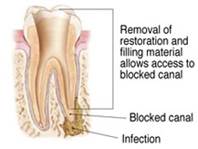
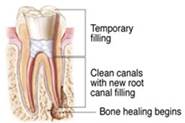
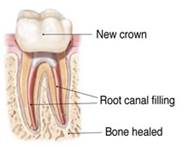
Like initial root canal therapy, the root canal space is opened through the biting surface of the tooth or existing crown. If the crown has a defective and open margin (allowing saliva into the interior), it is often removed. If present, all decay is removed. The existing root canal fillings are then removed and the root canal system is then carefully evaluated under the microscope. With the aid of CBCT imaging, any canals that were undiscovered during the prior root canal therapy are noted and treated. All canals are then shaped, sterilized using a multitude of medicaments and then re-sealed.
When endodontic retreatment is completed, the biting surface of the tooth may then be restored permanently (with a long-lasting restoration) or with a temporary filling. This depends on the request of your referring dentist. In many cases, further treatment with your general dentist will be required, as many teeth require the protection of a new crown following endodontic retreatment.
First time root canal therapy, along with endodontic retreatment are both performed under local anesthetic. We are are highly proficient in administering anesthetic and work with patients who are anxious and/or “difficult-to-get-numb" on a daily basis. Although certain tooth conditions can limit the effect of anesthetic, a patient should expect to be extremely comfortable. Again this, is our ultimate goal. Occasionally, nitrous oxide analgesia and/or oral conscious sedation is used in conjunction with our local anesthesia. Unlike first-time root canal therapy, endodontic retreatment often requires two separate visits each lasting 45 to 60 minutes. Between these visits, special medication is left within the canals to optimize the eradication of any resistant strains of bacteria.
What are the alternatives to endodontic retreatment?
Whenever possible, it is always best to save your natural tooth. A retreated tooth can function well for years, if not for a lifetime. Advances in technology are constantly changing and thus optimizing the success of endodontic retreatment.
There are times however, when a tooth with a persistent infection is not agreeable to endodontic retreatment. Many of these teeth may be better suited for endodontic surgery (discussed below). Other times, teeth with conditions of severe decay or deep splintering cracks simply can not be saved with any type of endodontic therapy and tooth removal may be necessary.
Following an in-depth clinical and radiographic evaluation, our endodontic team will thoroughly discuss your treatment options and determine whether endodontic retreatment, endodontic surgery, or tooth extraction is the best option for you.
Generally, root canal therapy or endodontic retreatment is all that is needed to save an infected or injured tooth from extraction. Occasionally however, non-surgical procedures alone will not be sufficient to heal the tooth. In such cases surgical root canal therapy may be recommended.
Why would I need endodontic surgery?
Patients who have had prior non-surgical therapy and still experience persistent infections and continued bone destruction of the jaw are candidates for surgical root canal therapy.
Endodontic surgery sees exceptional success in resolving continued infections caused by peri-apical cysts, resistant bacterial biofilms, microscopic cracks or canals at the root-end, and a number of other potential causes that can only be addressed by having access to the end of the root.
Surgical root canal therapy allows the advantage of direct observation of the end of the root. This enables the complete removal of resistant infection, stubborn pathologies (such as a cyst) and/or removal of bacterial biofilms that may cover the outer surface of the root.
Additionally, tiny microscopic cracks or canals within the root tip that do not appear on X-rays yet manifest themselves as tooth pain.
What is an apicoectomy?
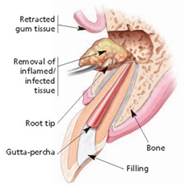
Although there are many surgical procedures that can be performed to save a tooth, the most common of these is called apicoectomy.
In this procedure, the end of the root is accessed by making a small incision in the gingiva. Typically the very end of the root is removed (roughly the width of a tooth pick), the root-end and surrounding area are cleaned and treated with medication and a small root-end filling is then placed to seal the end of the root canal.
Areas of bone that have been depleted as a result of the proceeding infection are typically replaced with a bone graph. Sutures are then placed to help the overlying gum tissue heal. These sutures are removed one week following the procedure.
Will I be comfortable during and after the procedure?
Local anesthetics make this an extremely comfortable procedure and most patients are able to return to their normal activities the following day.
Post-surgical discomfort is also generally very mild, as most sensitivity can be easily controlled with the use of anti-inflammatory medications. In most instances however, stronger pain medication is prescribed in conjuction with the use of an oral antibiotic and a prescribed anti-microbial mouth rinse.
What are the alternatives to endodontic surgery?
Most often, the only alternative to surgery is extraction of the tooth. The extracted tooth must then be replaced with an implant, bridge, or removable partial denture to restore chewing function and to prevent adjacent teeth from shifting. Because these alternatives require surgery or dental procedures on adjacent healthy teeth, endodontic surgery is typically the most biologic and cost-effective option in maintaining your oral health.
*images courtesy of www.aae.org

Contrary to popular belief, Lorem Ipsum is not simply random text. It has roots in a piece of classical Latin literature from 45 BC, making it over 2000 years old. Richard McClintock, a Latin professor at Hampden-Sydney College in
Virginia, looked up one of the more obscure Latin words, consectetur, from a Lorem Ipsum passage, and going through the cites of the word in classicaliterature, discovered the undoubtable source. Lorem Ipsum comes from sections 1.10.32 and 1.10.33 of "de Finibus Bonorum et Malorum" (The Extremes of Good and Evil) by Cicero, written in 45 BC.

Contrary to popular belief, Lorem Ipsum is not simply random text. has roots in a piece of classical Latin literature from 45 BC making over 2000 years old. Richard McClintock,
| Symtomps | Treatment | Price |
|---|---|---|
| Lorem ipsum dolor sit amet | Bioscopy | $150 - $250 |
| Lorem ipsum dolor sit amet | Bioscopy | $150 - $250 |
| Lorem ipsum dolor sit amet | Bioscopy | $150 - $250 |
| Lorem ipsum dolor sit amet | Bioscopy | $150 - $250 |

Contrary to popular belief, Lorem Ipsum is not simply random text. It has roots in a piece of classical Latin literature from 45 BC, making it over 2000 years old. Richard McClintock, a Latin professor at Hampden-Sydney College in
Virginia, looked up one of the more obscure Latin words, consectetur, from a Lorem Ipsum passage, and going through the cites of the word in classicaliterature, discovered the undoubtable source. Lorem Ipsum comes from sections 1.10.32 and 1.10.33 of "de Finibus Bonorum et Malorum" (The Extremes of Good and Evil) by Cicero, written in 45 BC.

Contrary to popular belief, Lorem Ipsum is not simply random text. has roots in a piece of classical Latin literature from 45 BC making over 2000 years old. Richard McClintock,
| Symtomps | Treatment | Price |
|---|---|---|
| Lorem ipsum dolor sit amet | Bioscopy | $150 - $250 |
| Lorem ipsum dolor sit amet | Bioscopy | $150 - $250 |
| Lorem ipsum dolor sit amet | Bioscopy | $150 - $250 |
| Lorem ipsum dolor sit amet | Bioscopy | $150 - $250 |

Contrary to popular belief, Lorem Ipsum is not simply random text. It has roots in a piece of classical Latin literature from 45 BC, making it over 2000 years old. Richard McClintock, a Latin professor at Hampden-Sydney College in
Virginia, looked up one of the more obscure Latin words, consectetur, from a Lorem Ipsum passage, and going through the cites of the word in classicaliterature, discovered the undoubtable source. Lorem Ipsum comes from sections 1.10.32 and 1.10.33 of "de Finibus Bonorum et Malorum" (The Extremes of Good and Evil) by Cicero, written in 45 BC.

Contrary to popular belief, Lorem Ipsum is not simply random text. has roots in a piece of classical Latin literature from 45 BC making over 2000 years old. Richard McClintock,
| Symtomps | Treatment | Price |
|---|---|---|
| Lorem ipsum dolor sit amet | Bioscopy | $150 - $250 |
| Lorem ipsum dolor sit amet | Bioscopy | $150 - $250 |
| Lorem ipsum dolor sit amet | Bioscopy | $150 - $250 |
| Lorem ipsum dolor sit amet | Bioscopy | $150 - $250 |

Contrary to popular belief, Lorem Ipsum is not simply random text. It has roots in a piece of classical Latin literature from 45 BC, making it over 2000 years old. Richard McClintock, a Latin professor at Hampden-Sydney College in
Virginia, looked up one of the more obscure Latin words, consectetur, from a Lorem Ipsum passage, and going through the cites of the word in classicaliterature, discovered the undoubtable source. Lorem Ipsum comes from sections 1.10.32 and 1.10.33 of "de Finibus Bonorum et Malorum" (The Extremes of Good and Evil) by Cicero, written in 45 BC.

Contrary to popular belief, Lorem Ipsum is not simply random text. has roots in a piece of classical Latin literature from 45 BC making over 2000 years old. Richard McClintock,
| Symtomps | Treatment | Price |
|---|---|---|
| Lorem ipsum dolor sit amet | Bioscopy | $150 - $250 |
| Lorem ipsum dolor sit amet | Bioscopy | $150 - $250 |
| Lorem ipsum dolor sit amet | Bioscopy | $150 - $250 |
| Lorem ipsum dolor sit amet | Bioscopy | $150 - $250 |

Contrary to popular belief, Lorem Ipsum is not simply random text. It has roots in a piece of classical Latin literature from 45 BC, making it over 2000 years old. Richard McClintock, a Latin professor at Hampden-Sydney College in
Virginia, looked up one of the more obscure Latin words, consectetur, from a Lorem Ipsum passage, and going through the cites of the word in classicaliterature, discovered the undoubtable source. Lorem Ipsum comes from sections 1.10.32 and 1.10.33 of "de Finibus Bonorum et Malorum" (The Extremes of Good and Evil) by Cicero, written in 45 BC.

Contrary to popular belief, Lorem Ipsum is not simply random text. has roots in a piece of classical Latin literature from 45 BC making over 2000 years old. Richard McClintock,
| Symtomps | Treatment | Price |
|---|---|---|
| Lorem ipsum dolor sit amet | Bioscopy | $150 - $250 |
| Lorem ipsum dolor sit amet | Bioscopy | $150 - $250 |
| Lorem ipsum dolor sit amet | Bioscopy | $150 - $250 |
| Lorem ipsum dolor sit amet | Bioscopy | $150 - $250 |

Contrary to popular belief, Lorem Ipsum is not simply random text. It has roots in a piece of classical Latin literature from 45 BC, making it over 2000 years old. Richard McClintock, a Latin professor at Hampden-Sydney College in
Virginia, looked up one of the more obscure Latin words, consectetur, from a Lorem Ipsum passage, and going through the cites of the word in classicaliterature, discovered the undoubtable source. Lorem Ipsum comes from sections 1.10.32 and 1.10.33 of "de Finibus Bonorum et Malorum" (The Extremes of Good and Evil) by Cicero, written in 45 BC.

Contrary to popular belief, Lorem Ipsum is not simply random text. has roots in a piece of classical Latin literature from 45 BC making over 2000 years old. Richard McClintock,
| Symtomps | Treatment | Price |
|---|---|---|
| Lorem ipsum dolor sit amet | Bioscopy | $150 - $250 |
| Lorem ipsum dolor sit amet | Bioscopy | $150 - $250 |
| Lorem ipsum dolor sit amet | Bioscopy | $150 - $250 |
| Lorem ipsum dolor sit amet | Bioscopy | $150 - $250 |

Contrary to popular belief, Lorem Ipsum is not simply random text. It has roots in a piece of classical Latin literature from 45 BC, making it over 2000 years old. Richard McClintock, a Latin professor at Hampden-Sydney College in
Virginia, looked up one of the more obscure Latin words, consectetur, from a Lorem Ipsum passage, and going through the cites of the word in classicaliterature, discovered the undoubtable source. Lorem Ipsum comes from sections 1.10.32 and 1.10.33 of "de Finibus Bonorum et Malorum" (The Extremes of Good and Evil) by Cicero, written in 45 BC.

Contrary to popular belief, Lorem Ipsum is not simply random text. has roots in a piece of classical Latin literature from 45 BC making over 2000 years old. Richard McClintock,
| Symtomps | Treatment | Price |
|---|---|---|
| Lorem ipsum dolor sit amet | Bioscopy | $150 - $250 |
| Lorem ipsum dolor sit amet | Bioscopy | $150 - $250 |
| Lorem ipsum dolor sit amet | Bioscopy | $150 - $250 |
| Lorem ipsum dolor sit amet | Bioscopy | $150 - $250 |